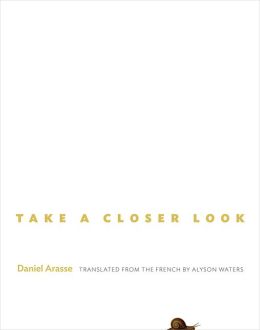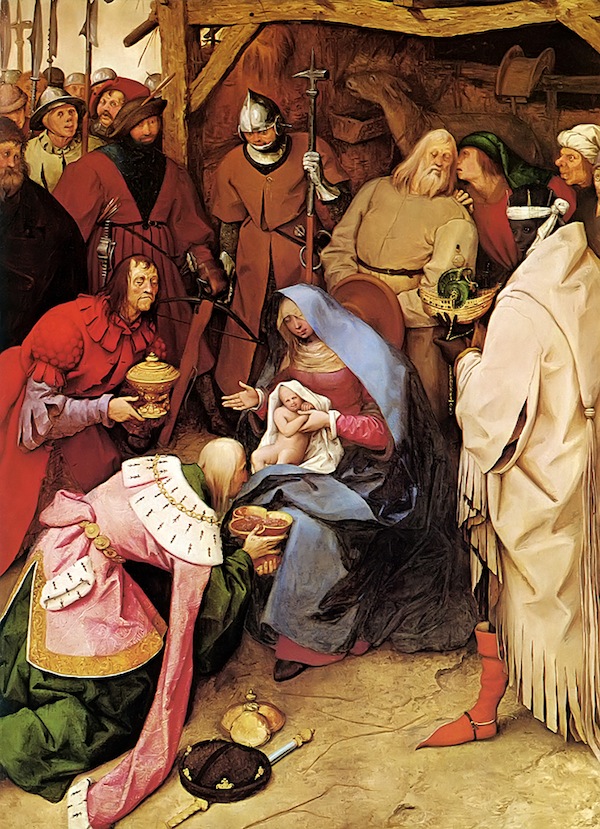Visual Arts Book Review: Looking at Paintings Beyond the Comfort Zone
Daniel Arasse’s method has been defined by his students as “looking, [taking] pleasure and [being] imprudent.” Any and every detail of a work of art can serve as his starting point.
Take a Closer Look, by Daniel Arasse. Translated from the French (On n’y voit rien: Descriptions; 2000, 2005) by Alyson Waters, Princeton and Oxford (Princeton University Press), 176 pages, $35.
By Gary Schwartz
The late Daniel Arasse (1944-2003) underwent one transformation after another in his early years. From a pied noir born in Oran, Algeria into a Frenchman indistinguishable from a native of the patrie; from a franco- to a franco-italophile; from a student of philosophy, language and literature to an historian of art; and from André Chastel as degree supervisor to Louis Marin. He describes the dissertation he was writing for Chastel as a daring departure. Chastel, he wrote, was an historian of the grand tradition, who took his own degree on “Art and humanism in Florence in the age of Lorenzo il Magnifico.” Arasse departed deliberately from that “main highway of the history of art” to a side road, taking as his subject “Art and society in the environs of St. Bernardino of Siena.” What he liked more than anything about St. Bernardino (1380-1444) was his main attribute, a lettered plaque, bridging Arasse’s two fields. In a slightly worried tone, he tells us thirteen years after Chastel’s death that his real model was not Chastel but Pierre Francastel and his book Peinture et société of 1965. Everything in Arasse’s scholarship and view of the world is fraught with anxious dualistic constructions.
In a disarming radio broadcast of 2003, the year of his early death, Arasse relates his change of supervisor to a traumatic experience he underwent as a graduate student. Having completed all his research for the dissertation on St. Bernardino, he came back to his parked car one day in Florence to find that the heavy artificial leather valise with all his notes and photos had been stolen. Rather than beginning again on the same subject, he moved from Chastel’s realm into Marin’s, working on the art of memory in later centuries. He never finished his dissertation, a detail he omits from his essay. Instead, he translated Frances Yates’s great book The Art of Memory into French.
Arasse characterizes his professional transfer with another heavy-going dialectical contrast, a particularly fascinating one. During the Middle Ages and Renaissance, he came to believe, the chief function of art was to support human memory. The complex system of Christianity and its societies, which gave structure to the lives of individuals and communities, demanded an ordering tool that could put everything in its proper place and help retrieve it when required. The iconographic art that was practiced up to and into the Renaissance was “a mnemonic system, juxtaposed, static, immutable, corresponding to a closed and hierarchical concept of the cosmos.” In the course of the fifteenth and sixteenth centuries it was replaced by “a rhetorical concept of painting, the exact opposite of the principles of the art of memory. Painting serves no more to recall something or other, but to convince, to move the spectator by what it tells.”
The above passages come from the printed version of a series of 25 radio monologues that Arasse completed heroically while suffering mortally from the degenerative muscle disease ALS. Half of broadcast 4 is on YouTube, “L’invention de la perspective.” It is a daringly reductionist conspiracy theory concerning the birth of linear perspective. After the mortal enemy of Cosimo de’ Medici, Palla Strozzi, ordered a magnificently “Gothic” Adoration of the Magi in 1425 from Gentile da Fabriano, it was obvious that “Cosimo il Vecchio, having [in 1434] returned [to Florence from a humiliating exile, following imprisonment by the Strozzi party] and having resumed power, could not choose for an art of the same kind. Political necessity demanded absolutely that he adopt a style diametrically opposed to that of the Strozzi, and that he adopt it with conspicuous conviction. That is why he opted for a sober art, inspired by toscanità….In the first place, perspective constructs an architectural location, a place, a place where History unfolds: History is made on urban space. It’s the idea of republican History.” As the program editor let us know in Histoires des peintures, Arasse spoke from notes. This affected the quality of his text as prose, but it gave his delivery a maximum of spontaneity, as if he were thinking as he went. He captured a wide audience, adding the general public to the circles of admirers he already had as a lecturer, a supervisor of dissertations and the study director of the Ecole des hautes études en sciences sociales (EHESS), one of the top positions in the academic world of France. Arasse was a phenomenon.
The book by Daniel Arasse that Princeton University Press has chosen to publish in translation could not be more different. Take a Closer Look is written in literarily awkward formats – the epistolary form, the second person, the author as third person, the dialogue, the soliloquy. The book begins, “Cara Giulia, You may find this rather long letter surprising, even a bit irritating.” I am sorry to say that I found it more than just a bit irritating. This is regrettable, because every page of the book contains original observations and suggestions that indeed brought me closer to the work of art under discussion. The kindest thing I can say about Arasse’s willful choices of genre is that the irritation is intended to deny the reader his or her comfort zone, the customary take-it-or-leave-it distance we enjoy from whatever a writer is laying before us. Take a Closer Look – the imperative English title is right on – puts you into the position of a graduate student who can’t just walk away from a discussion with their supervisor.
Arasse’s method has been defined by his students as “looking, [taking] pleasure and [being] imprudent.” Any and every detail of a work of art can serve as his starting point, with a preference for details that are unjustly taken for granted or motifs that don’t make sense if you think about them. Once having seized on one, he worries it from every conceivable angle. In the dialogue essay, about Titian’s Venus of Urbino in the Uffizi, the Arasse character relativizes one such convention, the interpretation of subordinate objects as attributes of the main figure:
“… those old iconographic ‘attributes’ of the Venus of Urbino, the myrtle in the window, the roses in the left hand, the two chests in the background, and the little dog asleep on the bed.”
“Usually, you like these attributes. An iconographer like yourself who is quoted everywhere…”
“Just because I’m an iconographer doesn’t mean I cannot see! And these attributes look suspicious to me.”
At which point he goes on to cast doubt on the relevance of the objects to the nude on the chaise-longue with her hand on her pussy. Who is she, anyway? Since she may be a bride or may be a courtesan, the meaning of the attributes will depend on the identity of the nude.
Without using words like “deconstruct,” Arasse goes on to question every aspect of the painting, as it appears on the canvas and as it is seen by observers. He quotes tons of them by heart, from Mark Twain to Mary Pardo. Like them, Arasse wants to know what the lady is doing with her fingers. After all the questioning and answering is done, he does not come further than a nod at “the erotics of painting.” In the meanwhile, though, he looks hard at the perspective and the picture space, noticing that the nude does not seem to inhabit the same space as the scene behind her:
“Venus occupies a precise place, that of the bed, situated between two spaces that are clearly defined and linked together: the fictional space of the room with the servants and the real space of the room from which we are looking at the painting. But the place of the bed escapes these two spaces. It occupies an area ‘between two spaces.’”
This is an interesting and sensible observation, although I’m not sure why Arasse has to bring the gallery space in the Uffizi into a discussion of the relation between Venus and the palace room behind her. However, I see no good reason why that passage has to be preceded by an annoying second voice – “So go ahead. Where is she? Let’s get this over with” – and why it is followed by “Could you kindly spare me such disagreeable jargon?” To which the first voice answers: “Let’s just say that the place of the bed – but I could also say the bed as place (of the naked body) – is between two spaces…” “That’s better.”
What’s better about it? The rephrasing, as I see it, is closer to jargon than the original statement. Arasse’s coquettish literary device gets in the way of what he is telling us about the painting. I found that unfortunately true of the entire book.
One of the six chapters (“Paint it Black”; the others are on Tintoretto; Franceso del Cossa; “Mary Magdalene’s ‘Fleece’”; and – with playfully disingenuous apologies – Velázquez’s Las Meninas) is on Pieter Bruegel’s Adoration of the Magi in the National Gallery in London. An element that Arasse brings out effectively is the exaggerated boorishness of the figures, up to and including the two white kings on the left. Beside the Virgin, only the black king on the right emanates an air of dignity. Once your attention is drawn to this, you grow increasingly disturbed by the “carnivalesque…, awkward…, crude…, coarse…” presentation of the scene, by its “comic mode” and looking like a “parody.” Why should the figures in such a sacred event, one of the staples of Christian iconography, be depicted as – speaking of the two white kings –“toothless, wasted old hippies,… doddering old men”? The main analytical tool that Arasse deploys in his search for an answer is to follow everyone’s gaze. The meaning assigned by the subjects to their own doings can surely be divined from what they are looking at. Unsurprisingly, this leads more often to new questions than to unequivocal solutions. One of the cutest in the Adoration is that the oldest king, kneeling before the Christ child, is staring emphatically in the direction of the baby boy’s genitals. Arasse invokes the authority of Leo Steinberg, in his magisterial The Sexuality of Christ in Renaissance Art and in Modern Oblivion (1983), to justify what looks like sheer prurience. “So there is nothing surprising about the fact that the old Magus needs to reassure himself, by seeing the Infant’s penis, that God’s ‘humanation’ (as Steinberg says) really happened.”
The problem that now presents itself is that Bruegel’s Christ child has no penis at all that we can see. Arasse wiggles out by saying that it is there, only hidden from us through the turn of the baby’s legs. The reader cannot help but ask why, if the reassuring view of the humanity of Christ is so essential to the event, does Bruegel leave it out? To this as well Arasse has a clever answer. Relating the painting to the Council of Trent, which the year before had “peremptorily reaffirmed the legitimacy of worshipping images and relics,” Arasse writes of the contemporaneous viewer of Bruegel’s painting (regretting that it is not an altarpiece) “blessed are they who do not see and yet believe.”
Reader, if you have the feeling that Arasse wants to have his cake and eat it too – well, so do I. The complexity of his arguments, the ways he doubles back on them and adopts standpoints opposed to what he has just written without disallowing the initial statement, may be a source of pleasure to Arasse, but I, presumably like Giulia, find it irritating. His answer to the dignity of the black king is another case in point. After pages of historical dialectic, Arasse ends up with nothing stronger than that “the humanity of the black man remained for Bruegel on the sidelines of the corrupted material practices of Europe and Roman Catholicism.” This is demonstrated through the mesh of gazes in the painting. In the same years that Titian was developing the erotics of painting, Arasse’s Bruegel was giving shape to the exotics of painting.
Throughout Take a Closer Look I had the feeling that I had stumbled into a battle between unidentified antagonists in the French art-historical arena, with factions from the Literature and Civilization corner in the Sorbonne, theorists and philosophers of the Ecole Normale Supérieure (ENS), socially inclined historians in Arasse’s EHESS, perhaps snipers from the Ecole du Louvre or the Institut Nationale d’Histoire de l’Art (INHA). You have to be a Sorbonnologist to tell what’s going on, and no program book is provided in the (excellent) Princeton translation. These insider scrimmages played a role, I suspect, in Arasse’s choice of literary formats, his use of the collateral rather than the jargon of critical theory, and his attempt to avoid the overbearingness of too much French scholarship and philosophy. On the surface, he succeeded, but the habits and attitudes he was trying to replace bubble up all around him as he goes. The book of writings by Arasse that I would most enjoy would be a bi-lingual, illustrated and annotated edition of Histoires des peintures, provided with a CD of the writer delivering his radio talks. That could give us the full complement of animated indiscretion that made this remarkable man so well-loved in France.
Gary Schwartz was born in Brooklyn, New York in 1940. In 1965 he came to the Netherlands with a graduate fellowship in art history and stayed. He has been active as a translator, editor, and publisher; teacher, lecturer, and writer; and as the founder of CODART, an international network organization for curators of Dutch and Flemish art. As an art historian, he is best known for his books on Rembrandt: Rembrandt: all the etchings in true size (1977), Rembrandt, his life, his paintings: a new biography (1984) and The Rembrandt Book (2006).
His Internet column, now called the Schwartzlist, appeared every other week from September 1996 to April 2007 and has been appearing since then irregularly.
In November 2009, Schwartz was awarded the coveted tri-annual Prize for the Humanities by the Prince Bernhard Cultural Foundation of Amsterdam.
He is the founding director, now emeritus, of CODART.
Responses always welcome at Gary.Schwartz@xs4all.nl.
Tagged: Alyson Waters, Daniel Arasse, French art, Princeton University Press, Take a Closer Look




